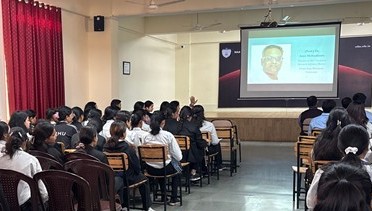Published on: March 21, 2025
Guest Lecture on Future Prospects in Biomedical Engineering with Focus on 3D Printing and Cancer Therapy
On 21st March 2025, the Department of Clinical Research, Himalayan Institute of Medical Sciences, in collaboration with the Himalayan School of Biosciences at Swami Ram Himalayan University, organized an insightful guest lecture titled “Future Prospects in Biomedical Engineering: Focusing on 3D Printing and Cancer Therapy.” The event took place at the Vishweshariya Auditorium, Himalayan School of Science and Technology, and was attended by 152 participants including undergraduate and postgraduate students, faculty members, and researchers.
The lecture was delivered by Prof. Dr. Amit Mehndiratta, Associate Professor at the Center for Biomedical Engineering, IIT Delhi, and a member of the University Research Advisory Board at SRHU. Dr. Amit shared his expert knowledge on the latest advancements in 3D printing technology and its transformative applications in the field of cancer therapy.
Dr. Mehndiratta began by introducing the fundamentals of 3D printing and its evolution within biomedical engineering. He highlighted the use of 3D printing in creating customized prosthetics, implants, and tissue engineering solutions. Special emphasis was placed on bioprinting—the process of fabricating artificial organs and tissues, which holds great promise for transplantation therapies. Challenges such as material compatibility, durability, and regulatory hurdles were also discussed.
A significant part of the lecture focused on how 3D printing is revolutionizing cancer treatment. Dr. Amit explained the development of patient-specific tumor models that allow for personalized treatment approaches. He described innovative 3D-printed drug delivery systems designed to target cancer cells more precisely, minimizing side effects. Additionally, the role of 3D printing in surgical planning and precision oncology was elaborated upon, along with emerging research on 3D-printed scaffolds to help regenerate tissues damaged by cancer.
Looking ahead, the lecture covered exciting future prospects, including 4D bioprinting—where printed structures can change over time—and the integration of artificial intelligence and machine learning to optimize 3D-printed biomedical solutions. Ethical considerations and regulatory challenges in adopting these new technologies were also discussed, emphasizing the need for careful implementation.
The session concluded with an interactive Q&A, where students and faculty engaged actively with Dr. Mehndiratta, posing questions on the practical feasibility of 3D-printed organs and the ethics of bioprinting in cancer research. The lecture received highly positive feedback for making complex scientific topics accessible and relevant.
The event was formally closed with a vote of thanks by Dr. Sanjay Gupta, Principal of the Himalayan School of Biosciences, who expressed gratitude to Dr. Amit Mehndiratta for his valuable insights and time.
This guest lecture enriched participants’ understanding of how biomedical engineering and 3D printing are shaping the future of cancer therapy, bridging academic knowledge with cutting-edge industry developments.



